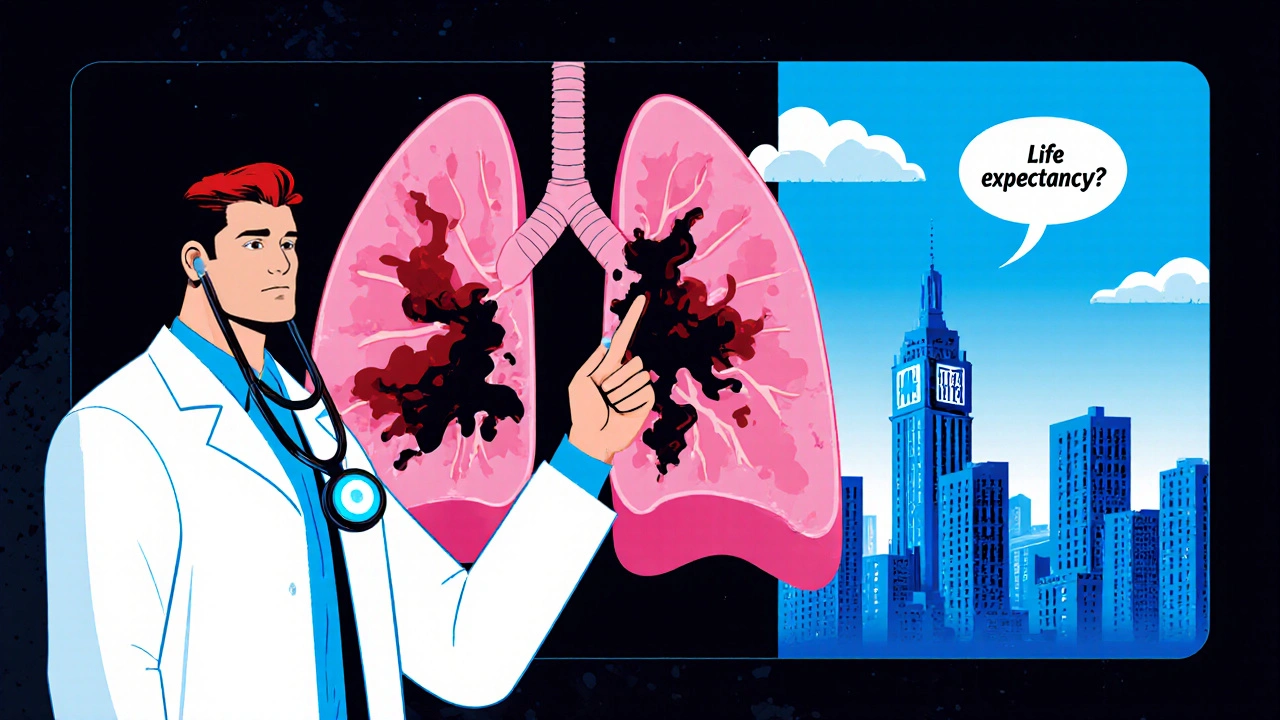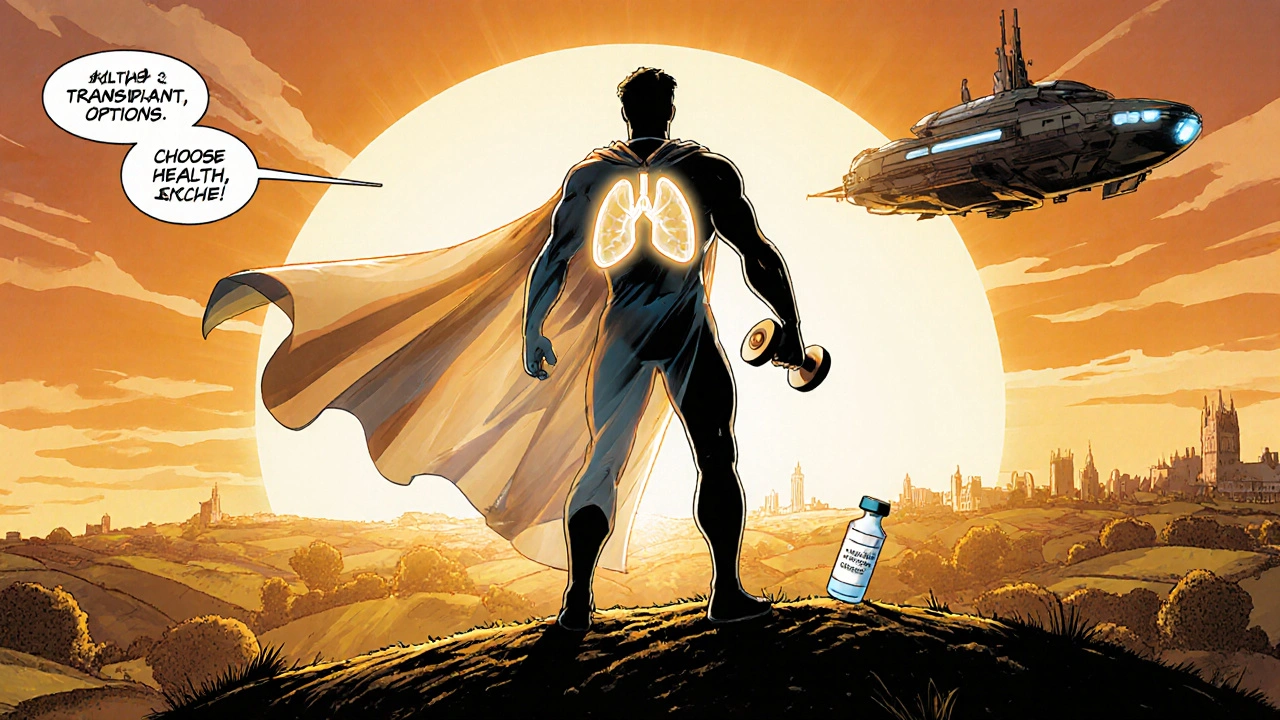
Emphysema Survival Calculator
Calculate Your Estimated Survival
When doctors talk about Emphysema is a progressive lung disease that destroys the air‑sac walls, reducing the lungs' ability to exchange oxygen and carbon dioxide, the biggest question most patients ask is how long they can expect to live. The answer isn’t a single number; it depends on disease severity, smoking status, comorbidities, and the treatments you receive. Below you’ll find the numbers, the factors that shift those numbers, and practical steps that can stretch your years.
Key Takeaways
- Average median survival after an emphysema diagnosis ranges from 5years (severe) to over 15years (mild).
- Smoking adds roughly 10years of lost life expectancy; quitting can regain up to 5years.
- The BODE Index is a proven prognostic tool; higher scores cut survival by half.
- Oxygen therapy, pulmonary rehabilitation, and timely lung‑transplant referral improve both quality and length of life.
- Genetic factors like Alpha‑1 Antitrypsin Deficiency accelerate decline, but targeted therapies can slow it.
What the Numbers Say
Researchers tracking thousands of patients with chronic obstructive pulmonary disease (COPD) - the umbrella term that includes emphysema - have published survival curves that are still referenced in 2024. A landmark UK cohort study (British Lung Foundation, 2023) reported median survival based on forced expiratory volume in one second (FEV₁) as a % of predicted:
- FEV₁≥80% (mild) - median 17years.
- FEV₁50‑79% (moderate) - median 11years.
- FEV₁30‑49% (severe) - median 6years.
- FEV₁<30% (very severe) - median 3‑4years.
These figures assume optimal medical care and no major comorbidities. When you add age, smoking pack‑years, and heart disease, the outlook shortens. That’s why clinicians lean on composite scores.
How the BODE Index Predicts Survival
The BODE Index combines Body mass index, airflow Obstruction, Dyspnea, and Exercise capacity (6‑minute walk distance). Each component scores 0‑3; the total ranges 0‑10. A simple rule of thumb:
- Score 0‑2: Median survival 12‑13years.
- Score 3‑4: Median survival 8‑9years.
- Score 5‑6: Median survival 5‑6years.
- Score 7‑10: Median survival <4years.
Because BODE captures more than lung function alone, it’s often a better guide for clinicians deciding when to start home oxygen or refer for transplant evaluation.
Smoking: The Biggest Modifiable Risk
Smoking drives emphysema progression faster than any other factor. A 2022 meta‑analysis of 45studies showed that current smokers with COPD lose on average 10years of life compared with never‑smokers. Quitting at any stage still yields a survival boost:
- Quit before age45≈+5years.
- Quit between 45‑60≈+3years.
- Quit after 60≈+1year.
The physiological reason is simple: ongoing smoke exposure inflames the airway, accelerates alveolar destruction, and worsens cardiovascular health. Use nicotine‑replacement or prescription aids; the earlier, the better.
Genetic Factors - Alpha‑1 Antitrypsin Deficiency
While most emphysema cases are smoking‑related, about1‑2% stem from Alpha‑1 Antitrypsin Deficiency, a hereditary lack of a protein that protects lung tissue. Patients often develop emphysema in their 30s‑40s, even without smoking. Early diagnosis through blood testing allows clinicians to prescribe augmentation therapy, which can add 2‑4years to median survival when started before significant lung damage occurs.
Treatment Options That Extend Life
Modern therapy isn’t just about inhalers. Here are the interventions proven to push the survival clock back:
- Long‑acting bronchodilators (LABA/LAMA) reduce exacerbations, a major cause of death.
- Home oxygen therapy for patients with PaO₂<55mmHg improves 5‑year survival by ~30%.
- Pulmonary rehabilitation boosts exercise capacity and lowers mortality risk by roughly 15%.
- Lung transplant offers a median post‑transplant survival of 6‑7years, extending life for those with BODE ≥7 who would otherwise survive less than 2years.
- Vaccinations (influenza, pneumococcal) prevent infections that can precipitate fatal exacerbations.
Combine these with regular follow‑ups and you’ll see the biggest gains, especially when you catch the disease early.

Quick Reference: Survival by Disease Stage
| Severity | FEV₁ % Predicted | Median Survival (years) | Typical BODE Score |
|---|---|---|---|
| Mild | ≥80% | 17 | 0‑2 |
| Moderate | 50‑79% | 11 | 3‑4 |
| Severe | 30‑49% | 6 | 5‑6 |
| Very Severe | <30% | 3‑4 | 7‑10 |
What You Can Do Today
Knowing the statistics is useful, but action changes them. Follow this checklist to give yourself the best shot at a longer, healthier life:
- Quit smoking - use a quit‑line or prescription aid within the next month.
- Schedule a spirometry test to know your exact FEV₁.
- Ask your doctor to calculate the BODE Index. If the score is 5 or higher, discuss oxygen therapy.
- Enroll in a local pulmonary rehabilitation program - many NHS trusts offer free slots.
- Get the flu and pneumococcal vaccines each year.
- If you have a family history of early‑onset emphysema, request an Alpha‑1 Antitrypsin test.
- Discuss lung‑transplant eligibility if your BODE score is 7‑10 or you’re living on home oxygen for >2years.
Frequently Asked Questions
How is life expectancy calculated for emphysema patients?
Doctors use a mix of lung‑function tests (FEV₁), symptom scores (like the Modified Medical Research Council dyspnea scale), and composite indices such as the BODE Index. These numbers feed into survival curves derived from large cohort studies, giving an estimate of median survival for a given disease stage.
Can oxygen therapy really add years to my life?
Yes. Landmark trials (the NOTT and MRC studies) showed that long‑term home oxygen for patients with severe hypoxemia cuts the risk of death by about 30% over five years, translating into roughly 2‑3 extra years of survival.
Is a lung transplant a cure?
A transplant replaces the damaged lungs, so it stops further emphysema‑related decline. However, the procedure carries risks (rejection, infection) and the average post‑transplant lifespan is 6‑7years. It’s a life‑extending option for those with very severe disease and limited alternatives.
Does age matter if I quit smoking now?
Age still influences baseline risk, but quitting at any age offers a measurable boost. A 65‑year‑old who quits can expect to gain up to 1‑2years compared with continuing to smoke, while a 40‑year‑old may add 4‑5years.
What role does exercise play in survival?
Regular aerobic activity improves the six‑minute walk distance, a key component of the BODE Index. Studies show that patients who complete pulmonary rehab have a 15% lower mortality rate over five years compared to those who remain sedentary.
Bottom Line
Emphysema does shrink life expectancy, but the degree of reduction varies widely. By quitting smoking, staying active, using oxygen when needed, and keeping an eye on the BODE score, you can turn a grim statistic into a more hopeful reality. If you’re in the severe range, talk early about transplant options - it could add several quality years you otherwise wouldn’t have.
Riley Fox
August 17, 2025 AT 04:06Ah, the grand tapestry of pulmonary degeneration-so often reduced to mere numbers, yet brimming with existential weight; one might argue that quantifying life expectancy is an exercise in hubris, doesn’t it? 🎭
Nevertheless, the data on emphysema survival are undeniably stark, punctuated by the cruel arithmetic of smoking‑induced decline.
Consider the BODE index-a multifactorial prognostic model that, when applied diligently, slices the median survival curve with surgical precision.
Yet every statistic hides a human story, a breath‑less moment that defies the cold calculus of epidemiology.
So, while calculators flash tidy year totals, remember that each year is a negotiation between biology and willpower.
Take heart, and perhaps a chuckle, for humor is the last refuge of those who refuse to surrender to deterministic fate. :)
David Stephen
August 17, 2025 AT 05:06Totally hear you-when the numbers look grim it’s easy to feel stuck, but even a modest step like a pulmonary rehab program can add meaningful weeks, sometimes months, to your timeline. Keep pushing, every breath counts.
John Blas
August 17, 2025 AT 06:06Drama aside, the calculator’s “10‑year penalty” feels more like a plot twist than reality; still, it reminds us how ruthless tobacco can be.
Darin Borisov
August 17, 2025 AT 07:53Within the contemporary discourse surrounding chronic obstructive pulmonary pathology, the lexicon of survival prognostication has become inextricably entwined with an array of multidimensional indices, each purporting to distill the complex interplay of physiological deterioration into a quantifiable metric. The BODE score, an acronymic amalgamation of Body mass index, Obstruction measured by FEV₁, Dyspnea assessed via the Medical Research Council scale, and Exercise capacity evaluated through the six‑minute walk test, epitomizes this methodological sophistication. Its utility transcends mere academic abstraction, offering clinicians a pragmatic framework whereby therapeutic stratification can be calibrated with a degree of precision previously unattainable. Nevertheless, the epistemic limitations inherent in any reductionist model must be acknowledged; variables such as genetic predisposition, environmental exposures, and psychosocial determinants elude categorical encapsulation. Moreover, the venerable doctrine of “mortality by the numbers” often neglects the phenomenological dimension of patient experience, wherein quality of life may supersede sheer longevity. In this vein, the advent of domiciliary oxygen therapy has demonstrated salutary effects not only on hypoxemic burden but also on the attenuation of right‑ventricular remodeling. Parallelly, lung volume reduction surgery, once relegated to the periphery of therapeutic armamentaria, now occupies a pivotal niche for select cohorts exhibiting heterogeneous emphysematous distribution. Emerging pharmacotherapies, targeting inflammatory cascades via phosphodiesterase‑4 inhibition or augmenting mucociliary clearance through novel mucolytics, further enrich the therapeutic tableau. Yet, one cannot eschew the incontrovertible truth that smoking cessation remains the singular, most potent modifier of disease trajectory, conferring up to five additional years of expectancy in former smokers. Counterintuitively, the epidemiological data reveal a non‑linear relationship between cessation timing and survival benefit, underscoring the urgency of early intervention. While the median survival figures delineated by FEV₁ percentiles furnish a macroscopic view-ranging from six years in severe obstruction to seventeen years in mild disease-the interindividual variance remains substantial. Consequently, clinicians are impelled to adopt a personalized approach, integrating objective metrics with patient‑centric goals. It is within this nuanced synthesis of evidence‑based medicine and individualized care that the true potential for extending both quantity and quality of life resides. Ultimately, the calculus of survival is not a static algorithmic output but a dynamic, evolving narrative shaped by medical innovation, behavioral modification, and the resilient human spirit.
Sean Kemmis
August 17, 2025 AT 08:53Stats are useful but they don’t tell the whole story; lifestyle changes matter.
Nathan Squire
August 17, 2025 AT 10:40Let’s be brutally honest: the calculator you see on the page is a glorified spreadsheet that spits out “adjusted years” based on two crude inputs-FEV₁ percentage and smoking status. While it serves as a handy educational teaser, it glosses over the myriad confounders that seasoned pulmonologists wrestle with daily. For instance, comorbidities like cardiovascular disease, the presence of alpha‑1 antitrypsin deficiency, and even socioeconomic factors can swing survival curves dramatically. Moreover, the so‑called “10‑year penalty” for current smokers is a blunt instrument; in reality, the hazard ratio per pack‑year is a continuous function rather than a stepwise deduction. If you’re a former smoker, the calculator adds five years, yet research shows that the benefit plateaus after the first few years of abstinence. The incorporation of the BODE index-something the tool entirely omits-would provide a more granular risk stratification. Oxygen therapy, pulmonary rehabilitation, and timely referral for lung transplantation also have quantifiable impacts on both mortality and quality‑adjusted life years. So, treat the output as an approximate guide, not a definitive verdict, and always corroborate with a comprehensive clinical assessment.
Matthew Marshall
August 17, 2025 AT 11:40Fine, numbers don’t lie, but they also don’t capture the fire in a survivor’s chest.
Lexi Benson
August 17, 2025 AT 13:26Smoking really does shave off a decade of your life.
Vera REA
August 17, 2025 AT 14:26The data presented aligns with the broader literature, indicating a clear dose‑response relationship between tobacco exposure and reduced survival in emphysema patients.
John Moore
August 17, 2025 AT 15:26Exactly-recognizing that relationship is the first step, and taking proactive measures like quitting, staying active, and following up with specialists can genuinely shift the odds in your favor.